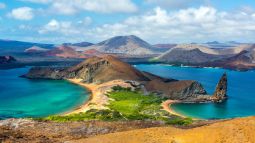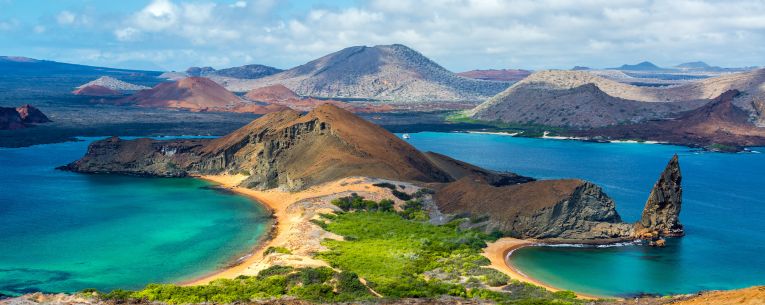Six hundred miles west of Ecuador, a cluster of volcanic islands rises from the sea. These are the lonely islands of the Galápagos, a place of stunning natural beauty that’s home to wildlife found nowhere else in the world. Species unique to the Galápagos include blue-footed boobies, giant tortoises and marine iguanas, the only lizard known to swim in the sea. The waters around the islands, where three ocean currents converge, are home to a dazzling array of marine life.
When’s the best time to visit the Galápagos? That depends on what you want to do and see. The weather is cooler and drier from June through November (although it’s not chilly; the average high is still 79 degrees F) and skies are often gray. Cold ocean currents make fish plentiful, attracting seabirds, sharks and whales. From December to May, temperatures are warmer and the weather alternates between rain showers and bright sunshine. Flowers bloom and sea turtles nest during these months.1
Hundreds of thousands of tourists make the trek to these islands each year, but access to the Galápagos is carefully controlled. To protect this fragile ecosystem, it’s crucial to follow the rules:
- Don’t approach or feed wildlife.
- Don’t bring any produce, plants or animals to the Galápagos.
- Clean boots and bags before you arrive to avoid bringing invasive seeds or organisms to the island.
Ready for a wild adventure? We’ll cover the basics of planning your journey to the Galápagos Islands.
3 reasons to buy travel insurance for the Galápagos
- In such a remote location, coverage for medical emergencies is essential. While there are two hospitals in the Galápagos, they can’t perform major medical procedures. This means that if you get seriously sick or hurt while visiting the islands, you’ll need to be evacuated to the mainland or to the United States. “This can cost $60,000 or more and take significant time to arrange,” the U.S. Department of State informs travelers. “We strongly recommend you purchase travel insurance that includes health coverage and air evacuation.”2
Trip insurance with emergency medical benefits can reimburse the cost of care for covered medical emergencies, while emergency transportation benefits can pay for a medical evacuation, if needed. - Travel insurance can protect your trip investment. Travel to the Galápagos isn’t cheap. Even short, budget-priced cruises start at $1,000 per person, while longer, luxury Galápagos cruises can cost close to $10,000. Many cruise companies have strict no-refund policies, meaning you could suffer a devastating financial loss if you must cancel the trip last minute. Travel insurance with trip cancellation/interruption benefits can reimburse you for nonrefundable, prepaid trip costs if you must cancel or interrupt your trip for a covered reason. The Cancel Anytime optional upgrade, available on OneTrip Prime and OneTrip Premier, can reimburse 80% of your lost non-refundable trip costs if you cancel your trip for almost any other unforeseeable reason.
- You don’t want travel delays to ruin your trip. If your flight to Quito or to the Galápagos is delayed, you may miss the boat entirely. Did you know that travel delay benefits can pay to help you catch up with your cruise ship or tour following a covered delay? You can also be reimbursed for additional accommodation, meals or travel expenses and lost prepaid expenses due to a covered departure delay.
What’s the best travel insurance plan for the Galápagos? If you’re traveling with children, we recommend OneTrip Prime or OneTrip Premier. These plans offer robust coverage for international travel, and both cover kids 17 and under for free when traveling with a parent or grandparent (not available on policies issued to Pennsylvania residents). The best option for frequent travelers may be AllTrips Premier, which covers all your trips for a full 365 days.
Remember: Every Allianz Travel Insurance plan includes 24-hour assistance for immediate help. Download the Allyz® app for rapid access to assistance.
3 ways to explore the Galápagos Islands
Take a cruise tour. Many travelers say the best way to see the islands is on a liveaboard boat that travels from island to island. No mammoth cruise ships are allowed; the largest ships carry only about 100 passengers, and their routes are controlled to minimize impact to the islands. Expect minimal shipboard activities, as nature is the main event. Itineraries range from four days to more than two weeks.
Establish a hotel home base. Stay in a hotel (most are on San Cristóbal Island or Santa Cruz Island) and then plan day trips by boat. You won’t be able to reach the most remote islands, and you’ll lose a portion of each day in transit, but the land-based approach can save you money on your Galápagos trip. Plus, hotel accommodations may be quite a bit more comfortable than a budget-priced cruise cabin.
Arrange a private yacht charter. While it’s certainly not an inexpensive way to see the Galápagos, chartering a private boat with captain and crew makes for a personalized experience you’ll never forget. If you’re traveling with a large group, it may make sense to consider this option. One Galápagos charter company says that for groups of 12 or more, the cost of a private cruise can be the same as booking cabins on a shared boat.3
Read more: Planning a Private Cruise Adventure
3 of the best islands to visit in the Galápagos
Isabela Island, the largest of the Galápagos’ 19 islands, is a dramatic landscape of volcanic peaks and lava fields. “The island’s rich fauna is beyond compare,” the Galápagos Conservancy says.4 Isabela is home to the Galápagos’ largest population of wild tortoises, with a separate species on each volcano, as well as one of the world’s rarest birds, the mangrove finch. The town of Villamil is charming, with white-sand beaches and flamingo lagoons.
San Cristóbal is where you’ll find the provincial capital, Puerto Baquerizo Moreno, which is a good jumping-off point for day trips. Attractions on San Cristóbal include Frigatebird Hill, where you can watch Magnificent Frigatebirds and Great Frigatebirds soaring, a sea lion rookery, and the tortoise reserve. Hike to Punta Pitt for spectacular views and a chance to see all three of the islands’ booby species.
Española Island is one of the oldest and most isolated islands, making it a haven for unusual wildlife. It’s best known as the sole breeding colony of the Waved Albatross; between April and December, nearly the entire population of the adult birds comes to Española to participate in elaborate mating rituals and raise their chicks. Española is also home to a giant tortoise species that, after nearly going extinct in the 1960s, is now thriving.5
Don’t forget to buy travel insurance for your Galápagos expedition! See affordable plan options from Allianz Travel Insurance.
What Do I Need to Travel to the Galápagos Islands?








Share this Page